To create a Japandi kitchen that blends elegance and simplicity, embrace natural materials like wood and stone, and opt for earthy color tones to evoke tranquility. Incorporate open shelving for a functional yet aesthetic touch, and choose minimalist cabinetry to maintain clean lines. Add greenery for a revitalizing vibe and consider sustainable choices to enhance your space. By focusing on a harmonious flow, you’ll discover more ways to elevate your kitchen’s style seamlessly.
1.Embrace Natural Materials
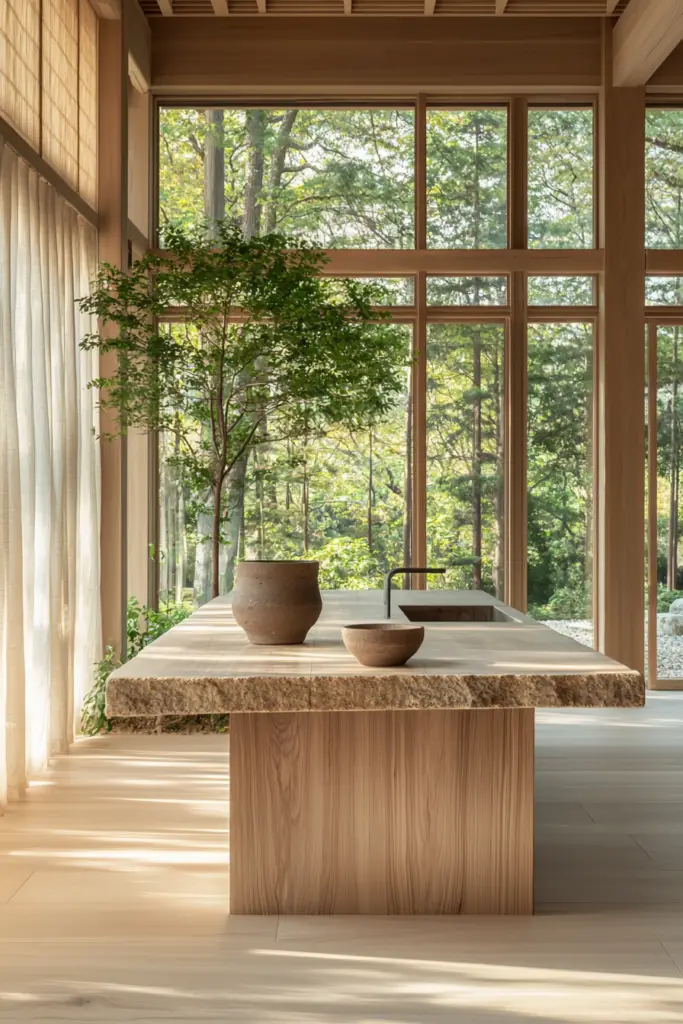
When you embrace natural materials in your Japandi kitchen, you create a serene and inviting atmosphere that fosters both functionality and beauty. Picture warm wood cabinetry, its rich grains echoing the tranquility of nature. Incorporating stone countertops, with their unique textures, adds a touch of elegance while ensuring durability. Bamboo accents can enhance the space, offering a sustainable and stylish touch. You might consider ceramic dishware, whose organic shapes complement the overall aesthetic. Natural fibers, like jute or linen, in curtains or rugs bring warmth and softness to the design. Each material you choose not only serves a purpose but also tells a story, uniting simplicity and sophistication in your kitchen, making it a delightful space for both cooking and gathering.
2.Opt for a Neutral Color Palette
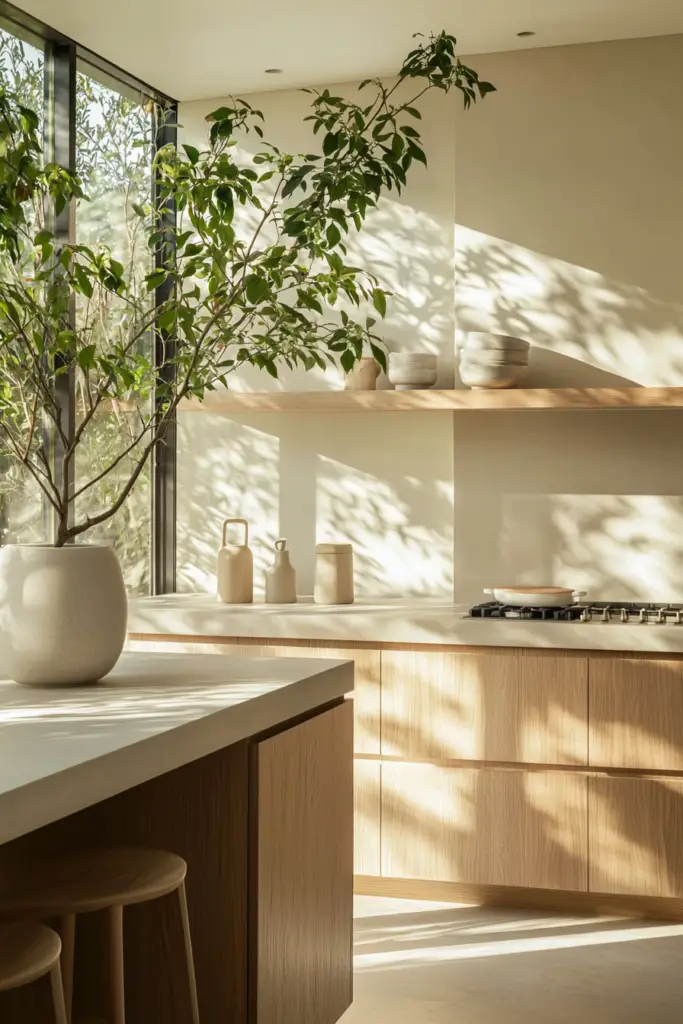
Natural materials set the stage, and a neutral color palette enhances the serene vibe of your Japandi kitchen. Imagine soft beiges, muted grays, and warm whites flowing seamlessly together, creating an inviting atmosphere. These colors not only promote tranquility but also allow the beauty of natural wood and stone to shine. You’ll find that a neutral palette can make your space feel larger and more open, fostering a sense of calm amidst the bustle of daily life. Pairing these hues with minimalist decor guarantees that your kitchen remains functional yet aesthetically pleasing. Whether you choose matte finishes or subtle textures, a neutral color scheme invites balance and harmony, embodying the essence of Japandi design perfectly.
3.Incorporate Open Shelving
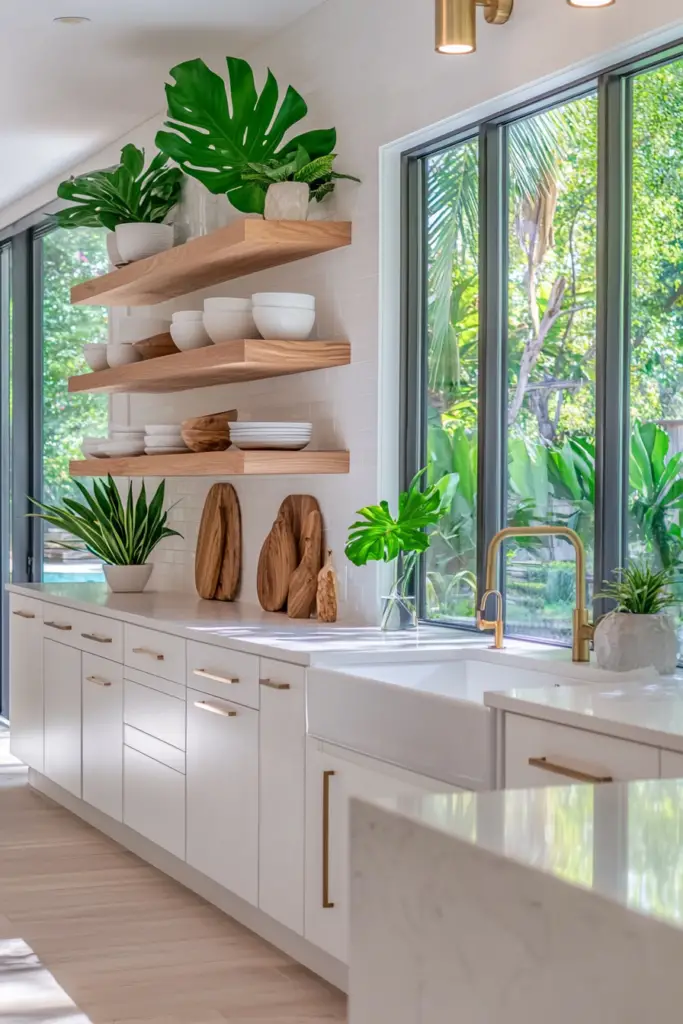
Incorporating open shelving into your Japandi kitchen not only enhances its aesthetic appeal but also promotes functionality. These shelves create a sense of airiness, allowing natural light to flow through the space while showcasing your curated collection of dishware, plants, or cookbooks. Choose materials like light wood or sleek metal to maintain that minimalist vibe. You’ll find that displaying your most-used items encourages a sense of order and accessibility, making cooking more enjoyable. To keep the look cohesive, stick to a muted color palette that complements your overall theme. The result is a kitchen that feels both inviting and streamlined, perfectly marrying elegance and simplicity in a way that reflects your personal style.
4.Choose Minimalistic Cabinetry
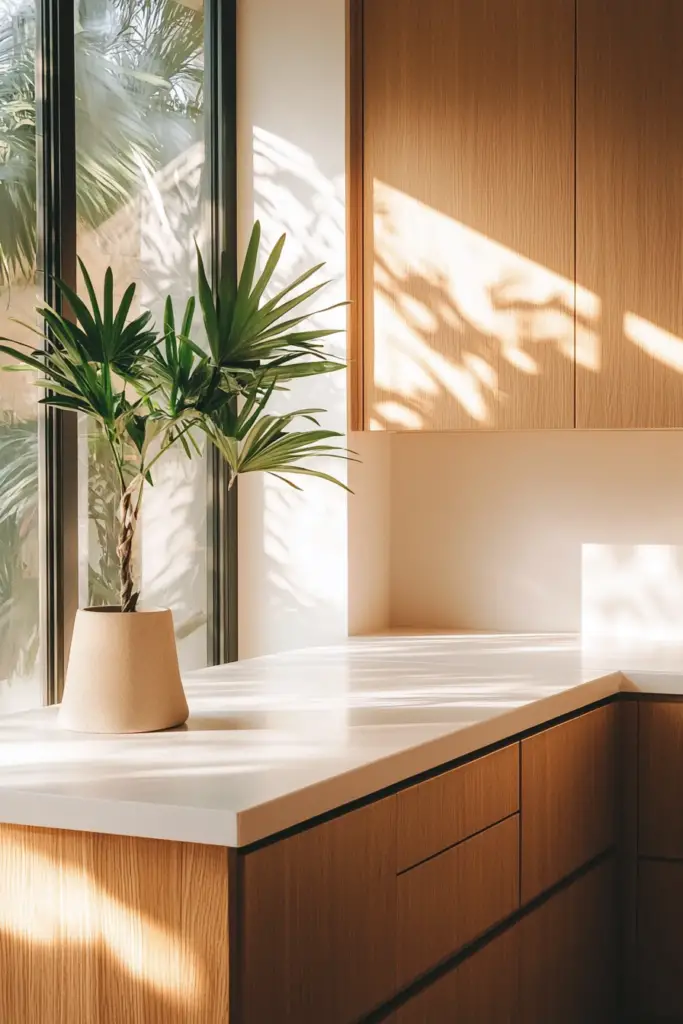
Choosing minimalistic cabinetry is essential for achieving that serene Japandi aesthetic. Opt for clean lines and muted colors, like soft whites, deep woods, or gentle grays. These choices create a cohesive and calming atmosphere, allowing your kitchen to breathe. Consider flat-panel doors without ornate handles to enhance simplicity, giving your space a modern touch.
Functional storage solutions, such as pull-out shelves and hidden compartments, keep clutter at bay while maintaining elegance. The focus should be on practicality, ensuring everything you need is easily accessible yet discreetly tucked away. By choosing minimalistic cabinetry, you not only elevate the visual appeal but also contribute to a tranquil environment that reflects the harmony of Japandi design. Keep it simple, and let your kitchen shine.
5.Utilize Textured Fabrics
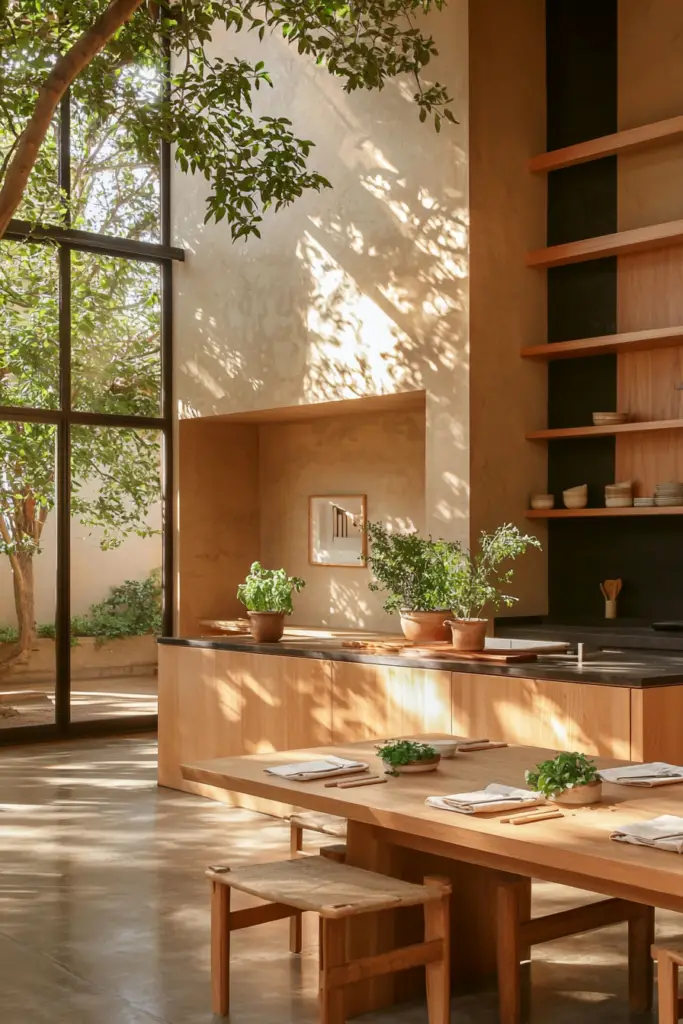
To enhance the serene atmosphere of your Japandi kitchen, consider utilizing textured fabrics that add warmth and depth. Think about incorporating linen tablecloths or cotton dish towels in soft, neutral tones. These materials not only bring a tactile element but also harmonize beautifully with the minimalistic style. You could hang a simple linen curtain to soften natural light while maintaining a clean look. Textured fabrics can also be used in cushions for a small seating area, inviting comfort without overwhelming the space. Opt for subtle patterns or natural dyes that resonate with the Japandi aesthetic, creating an inviting yet sophisticated environment. By thoughtfully integrating these elements, you’ll achieve a balanced and cozy kitchen that feels both elegant and functional.
6.Add Greenery for a Touch of Nature

There’s something magical about adding greenery to your Japandi kitchen that instantly breathes life into the space. Incorporating plants, whether it’s a sleek succulent on the windowsill or a cascading pothos hanging above your countertops, creates a serene environment. Choose low-maintenance options like herbs or snake plants that not only purify the air but also add a pop of color. Arrange them in simple, minimalist pots that harmonize with your kitchen’s aesthetic, enhancing the overall elegance. This natural touch complements the wood and neutral tones typical of Japandi design, fostering a sense of calm. Plus, having fresh herbs at your fingertips not only looks good but elevates your cooking experience. Embrace the beauty of nature in your kitchen.
7.Focus on Functional Layouts
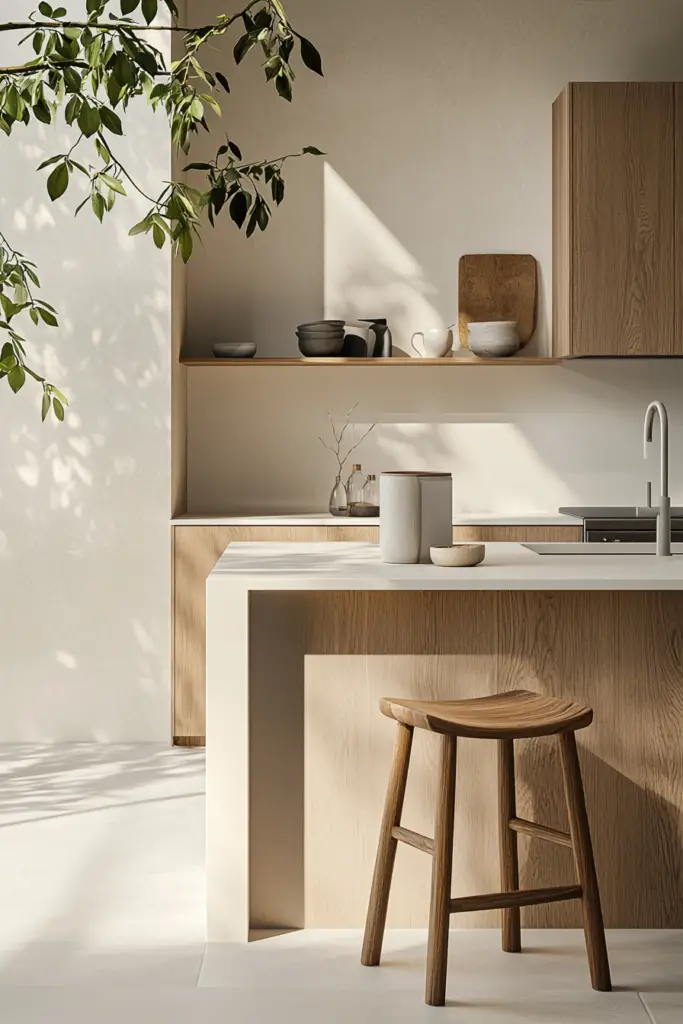
While a beautifully designed kitchen captures attention, the true heart of a Japandi kitchen lies in its functional layout. You’ll want to prioritize an efficient workflow that makes cooking and gathering a breeze. Imagine an open space where every element has its purpose—cabinets neatly align with countertops, ensuring easy access to essentials. Use a minimalist island for prep work, creating a natural gathering spot for family and friends. Opt for hidden storage solutions to maintain a clean look, allowing your space to breathe. Incorporate natural materials and muted color palettes to enhance the serene atmosphere. In this harmonious environment, simplicity and elegance come together, allowing your kitchen to be both a functional workspace and a warm haven for culinary creativity.
8.Integrate Japanese Elements
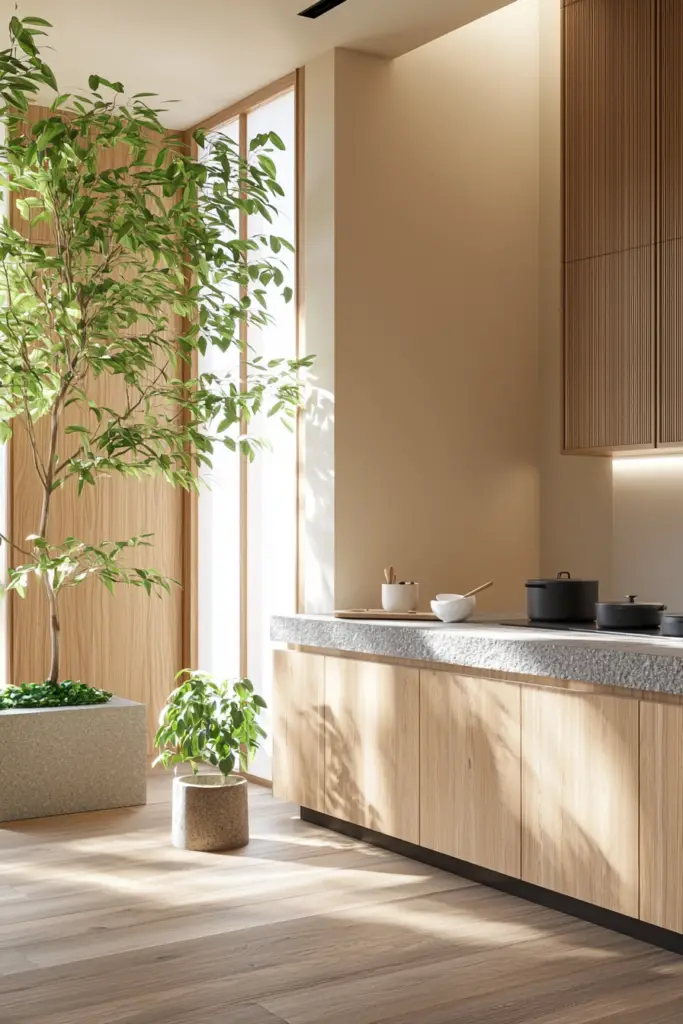
Incorporating Japanese elements into your kitchen design can elevate its aesthetic and functionality, seamlessly blending tradition with modernity. Consider using natural materials like bamboo or wood for cabinetry and countertops, creating a warm, inviting atmosphere. Shoji screens can replace traditional cabinet doors, providing a touch of elegance while allowing soft light to filter through. Minimalist lines and a neutral color palette can enhance the space’s simplicity, promoting a sense of calm. Add decorative touches like ceramic dishware or handmade pottery, which reflect Japanese craftsmanship. Incorporate plants, such as bonsai or herbs, to accentuate the connection to nature. These thoughtful details not only beautify your kitchen but also create a serene environment that encourages mindfulness and appreciation for simplicity.
9.Consider Built-in Appliances
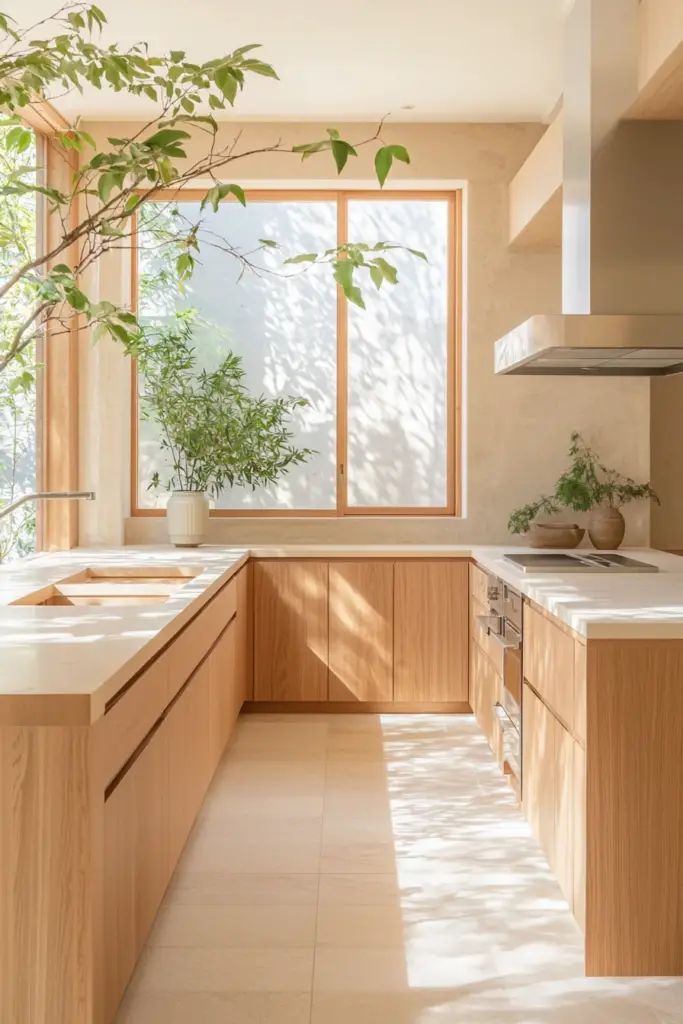
To enhance the harmonious blend of Japanese and Scandinavian design in your kitchen, consider the elegance of built-in appliances. These sleek, integrated units not only save space but also create a seamless look that embodies minimalism. Imagine a refrigerator that sits flush with cabinetry, its clean lines complementing natural wood finishes and soft colors. Built-in ovens, too, blend effortlessly, allowing for a streamlined aesthetic that prioritizes functionality without sacrificing style. You’ll find that these appliances can be designed to match your cabinetry, enhancing the overall tranquility of your space. This subtle integration fosters an uncluttered environment, inviting calmness and simplicity into your daily cooking routines. Embrace the beauty of built-in appliances for a refined Japandi kitchen that feels both elegant and purposeful.
10.Use Simple and Elegant Lighting
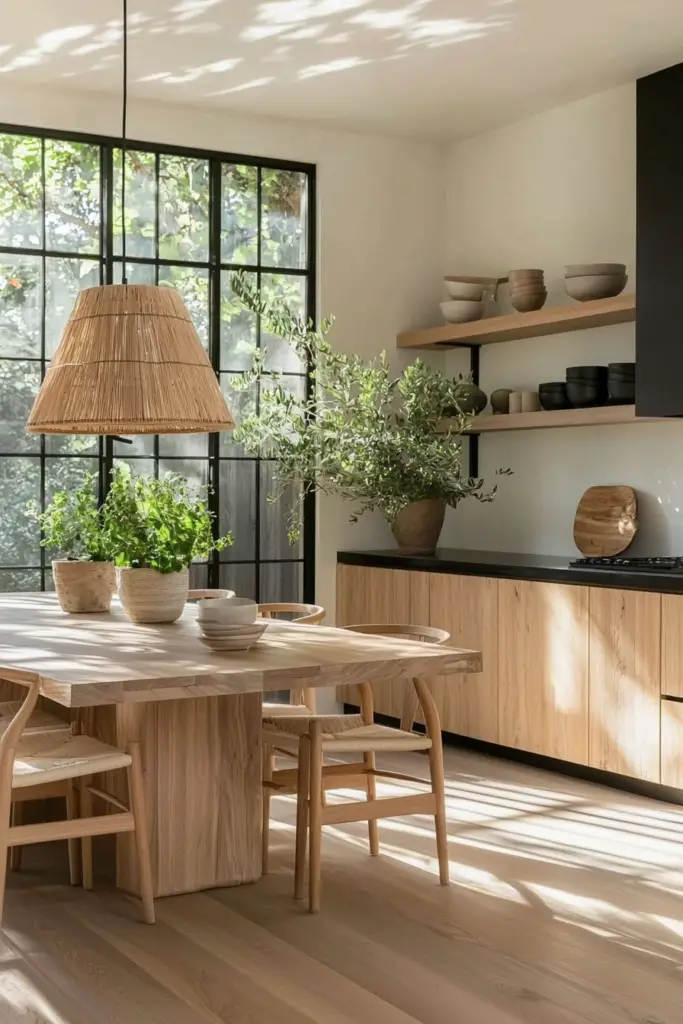
As you curate your Japandi kitchen, selecting simple and elegant lighting can greatly enhance the serene atmosphere. Consider pendant lights with clean lines and soft tones that complement your space without overwhelming it. A minimalist chandelier or sleek wall sconces can add a touch of sophistication while keeping the overall look uncluttered. Opt for warm LED bulbs to create a cozy ambiance, inviting you to unwind after a long day. Dimming options are also worth considering, allowing you to adjust the brightness according to the time of day or mood. Remember, the goal is to illuminate your kitchen in a way that highlights its beauty while maintaining that signature Japandi balance of functionality and elegance.
11.Highlight Natural Wood Finishes
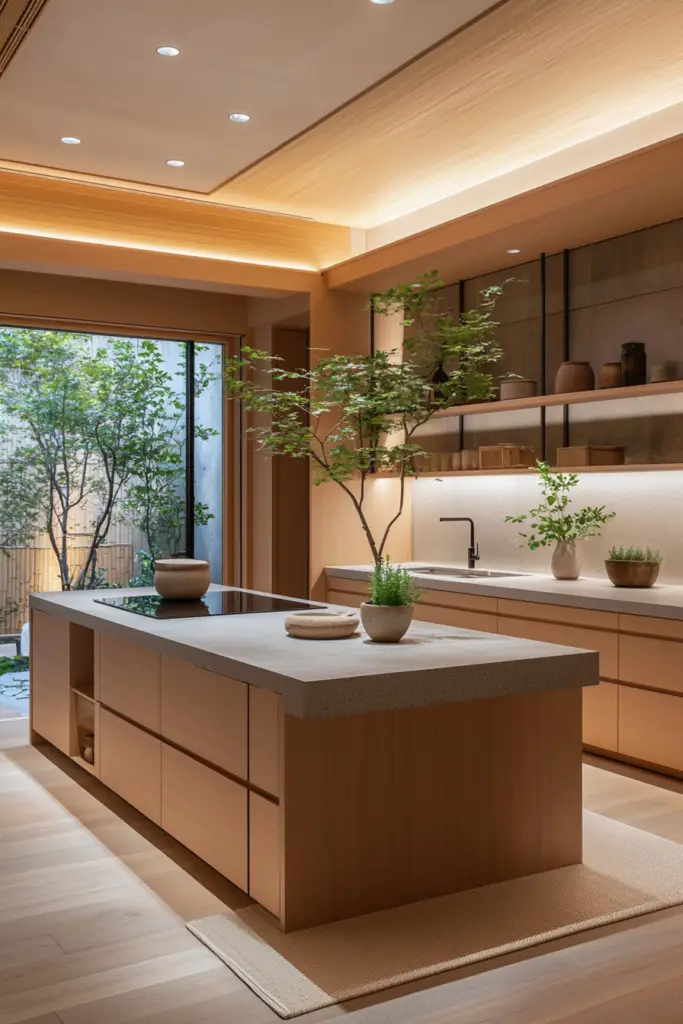
The choice of lighting sets the stage for your Japandi kitchen, but it’s the natural wood finishes that truly bring warmth and character to the space. Embrace rich oak or walnut cabinets that showcase the unique grain patterns, adding depth to minimalist designs. When you incorporate open shelving, you’ll not only display beautiful dishware but also highlight the lovely textures of the wood. Consider a natural wood island for a functional centerpiece, where you can prep meals or gather with family. Pair these finishes with neutral tones for a cohesive look that feels both inviting and serene. By focusing on natural wood, you’re creating an organic connection to nature, essential for achieving that Japandi balance of elegance and simplicity.
12.Keep Countertops Clutter-Free
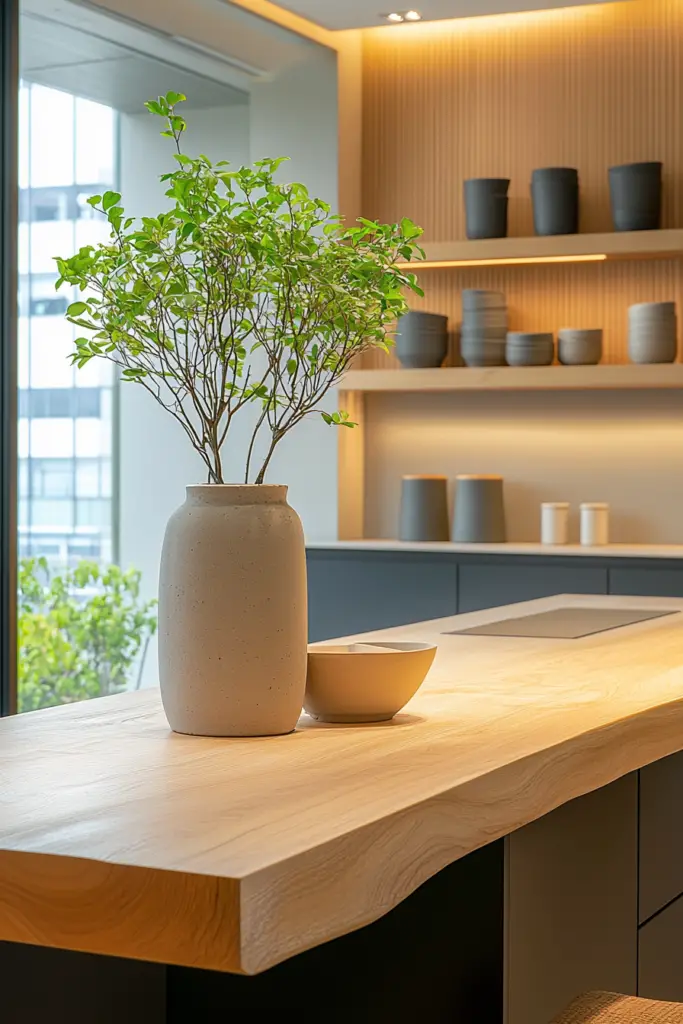
A clutter-free countertop can transform your Japandi kitchen into a serene and functional workspace. By minimizing distractions, you create an inviting area that encourages creativity and calm. Start by selecting essential items that truly belong on your counter—think beautiful wooden cutting boards or elegant ceramic containers. Consider stylish storage solutions, like woven baskets or sleek drawer organizers, to keep tools and utensils tucked away. When everything has a designated spot, the clean lines and simplicity of your design shine through. You’ll find joy in preparing meals without the chaos of clutter. Remember, less is more in Japandi design; each piece should serve a purpose while contributing to the overall aesthetic harmony of your kitchen.
13.Incorporate Stone Accents
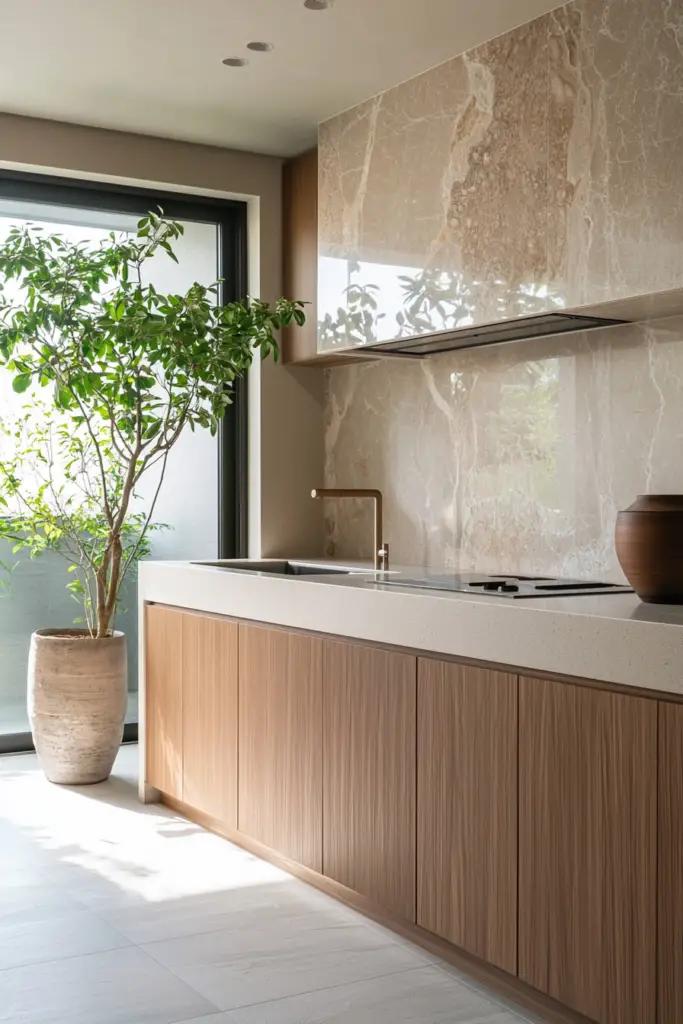
While you might think of wood and minimalism as the cornerstones of Japandi design, incorporating stone accents can elevate the aesthetic to new heights. Imagine a sleek, granite countertop that contrasts beautifully with warm wooden cabinetry. The textural interplay of stone adds depth and sophistication, creating a striking focal point in your kitchen. You could also consider a stone backsplash, with its natural patterns and hues, bringing a touch of organic beauty to the space. Pairing stone with simple, functional elements enhances the overall serene atmosphere. Whether you opt for polished marble or rugged slate, these accents ground the design, marrying elegance with practicality. With stone, your Japandi kitchen can achieve a harmonious balance that feels both inviting and refined.
14.Blend Modern and Traditional Styles
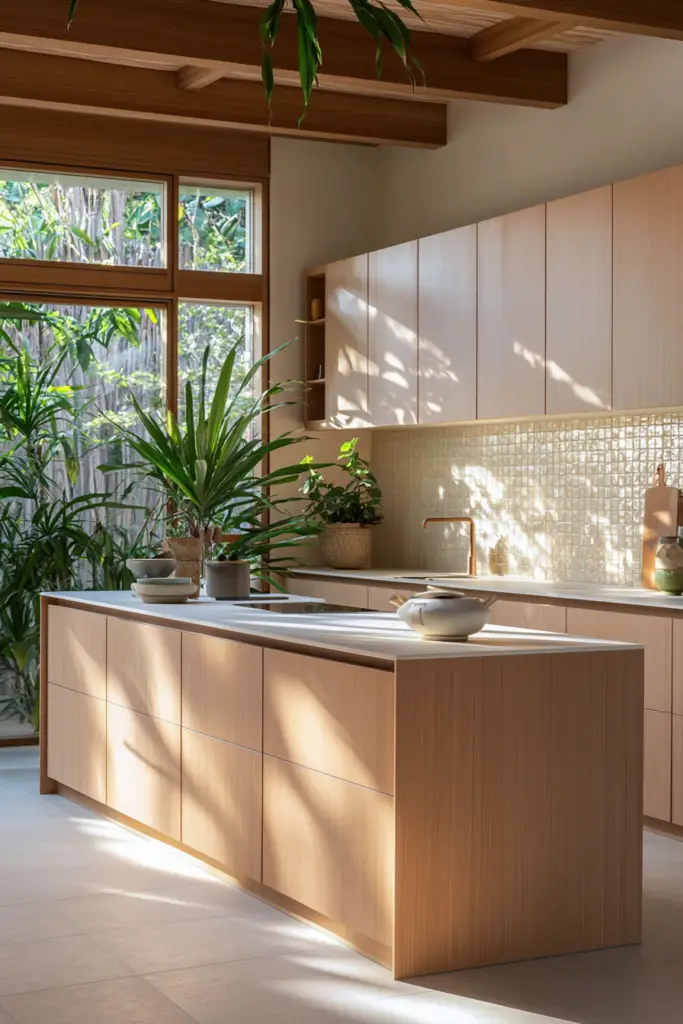
By seamlessly blending modern and traditional styles, you can create a Japandi kitchen that feels both timeless and fresh. Start with clean lines and minimalist cabinetry to capture the modern essence, then introduce warm, natural materials like wood or bamboo for a touch of tradition. Consider pairing sleek, white countertops with rustic wooden shelves; this contrast highlights both styles beautifully. You might also incorporate handcrafted ceramics or vintage accessories that echo traditional craftsmanship, adding character without overwhelming the space. Soft, neutral color palettes enhance simplicity while allowing for an inviting atmosphere. By thoughtfully balancing these elements, you’ll achieve a harmonious kitchen that reflects your unique taste, combining elegance with functionality in perfect Japandi style.
15.Select Sleek Hardware
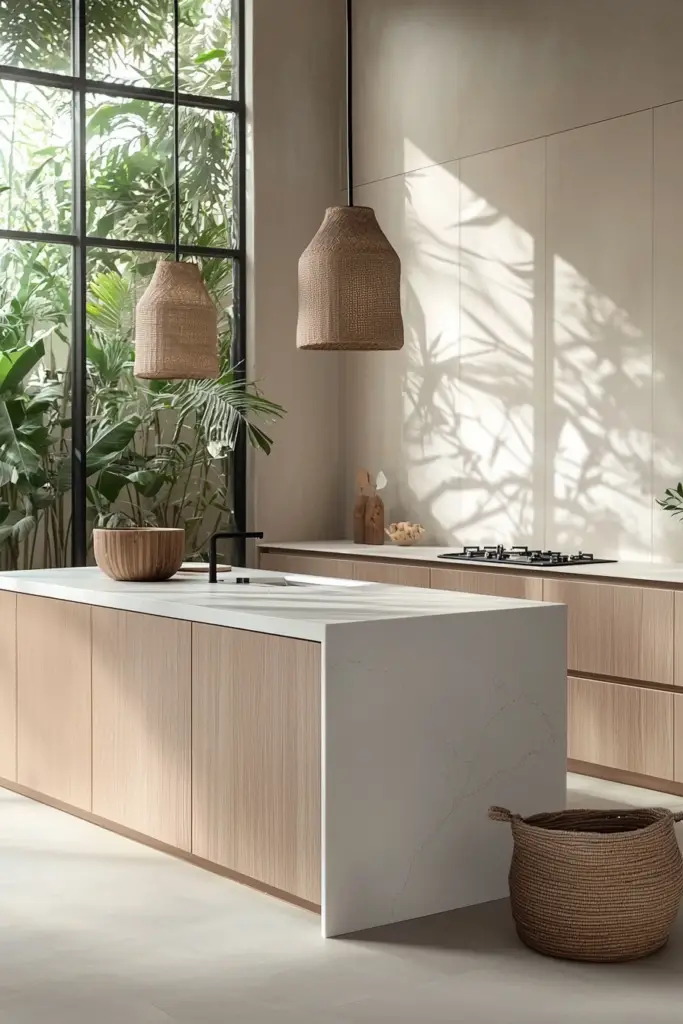
Sleek hardware serves as the finishing touch in a Japandi kitchen, marrying beauty with functionality. Opt for minimalist knobs and handles made from matte black, brushed brass, or stainless steel. These choices not only exude sophistication but also provide a tactile experience, enhancing your daily kitchen interactions. Consider concealed hinges for cabinetry; they create a seamless look, emphasizing clean lines. When selecting drawer pulls, aim for simple shapes that echo the natural materials often found in Japandi design. Remember, each piece should harmonize with your overall aesthetic while ensuring ease of use. The right hardware elevates your kitchen’s elegance, making it a space where style and practicality coexist beautifully.
16.Create a Zen Atmosphere
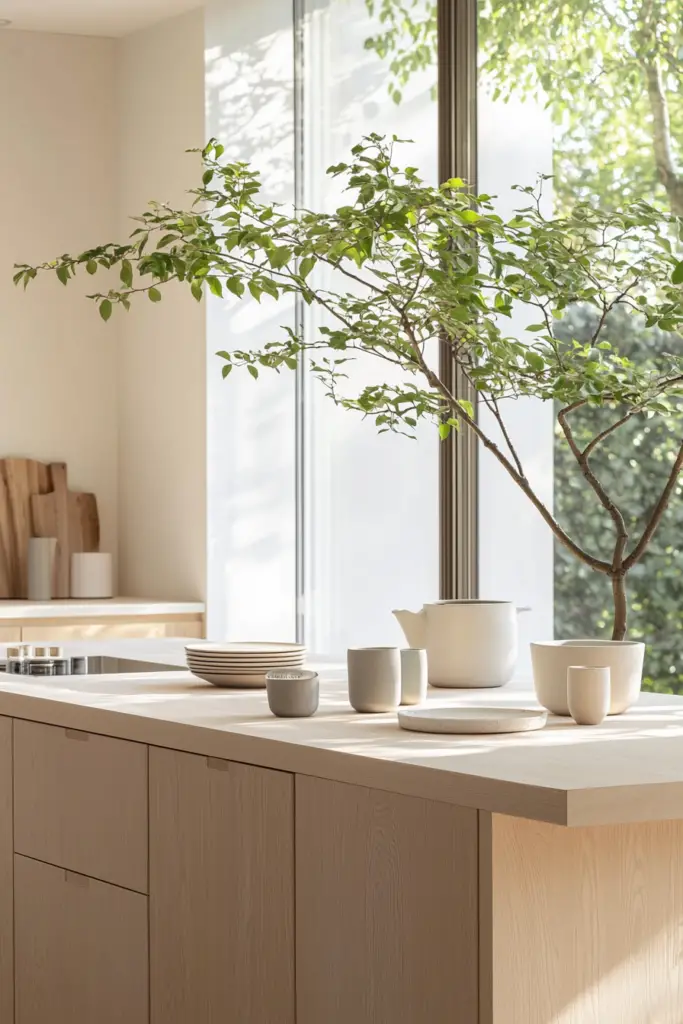
To create a Zen atmosphere in your Japandi kitchen, consider the interplay of light, color, and natural elements. Soft, diffused lighting enhances tranquility, so opt for warm bulbs that mimic the glow of natural sunlight. Choose a muted color palette, focusing on earthy tones like soft browns, greens, and whites to evoke a sense of calm. Incorporate natural materials such as bamboo or stone, which connect the indoors to nature. Minimalistic decor, like potted herbs or simple wooden utensils, keeps the space uncluttered and serene. Open shelving can display these elements beautifully, promoting a feeling of harmony. By embracing simplicity and nature, your kitchen will become a peaceful retreat where you can unwind and create with ease.
17.Utilize Multi-functional Furniture
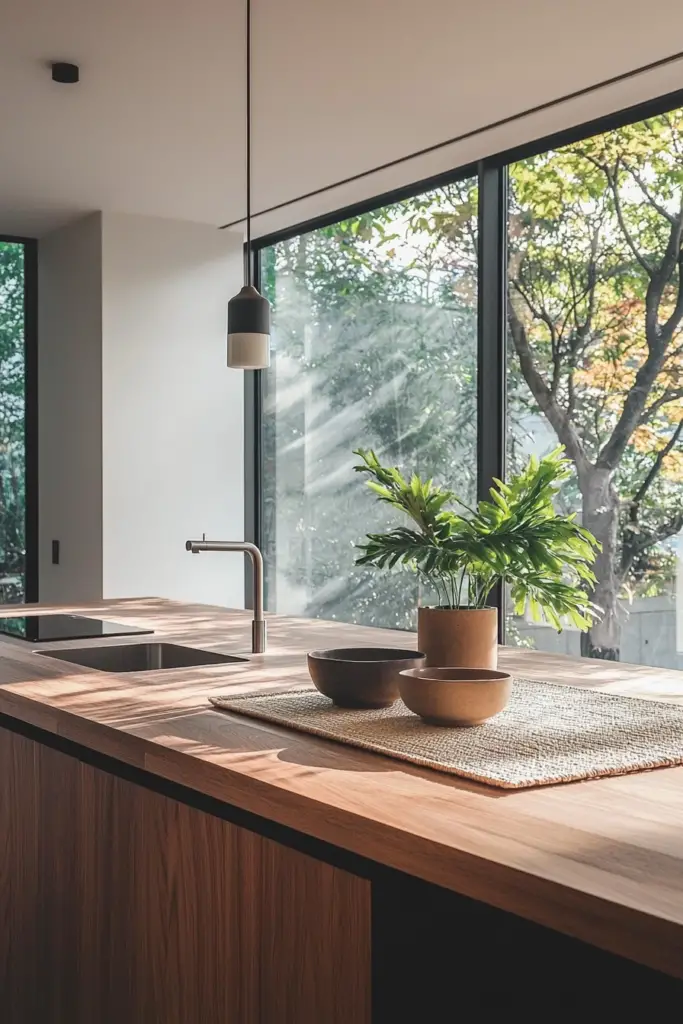
While you may think a kitchen needs to be filled with separate, bulky pieces of furniture, embracing multi-functional designs can transform your Japandi space into a harmonious and efficient haven. Picture a sleek kitchen island that not only serves as a prep area but also offers additional storage and dining space. Consider a bench that doubles as a seat and a hidden compartment for kitchen tools. By selecting pieces that serve multiple purposes, you minimize clutter while enhancing functionality. This approach encourages a serene atmosphere, allowing you to focus on the beauty of simplicity. Ultimately, multi-functional furniture not only maximizes your space but also aligns perfectly with the Japandi philosophy of elegance combined with practicality.
18.Choose Simple Tableware
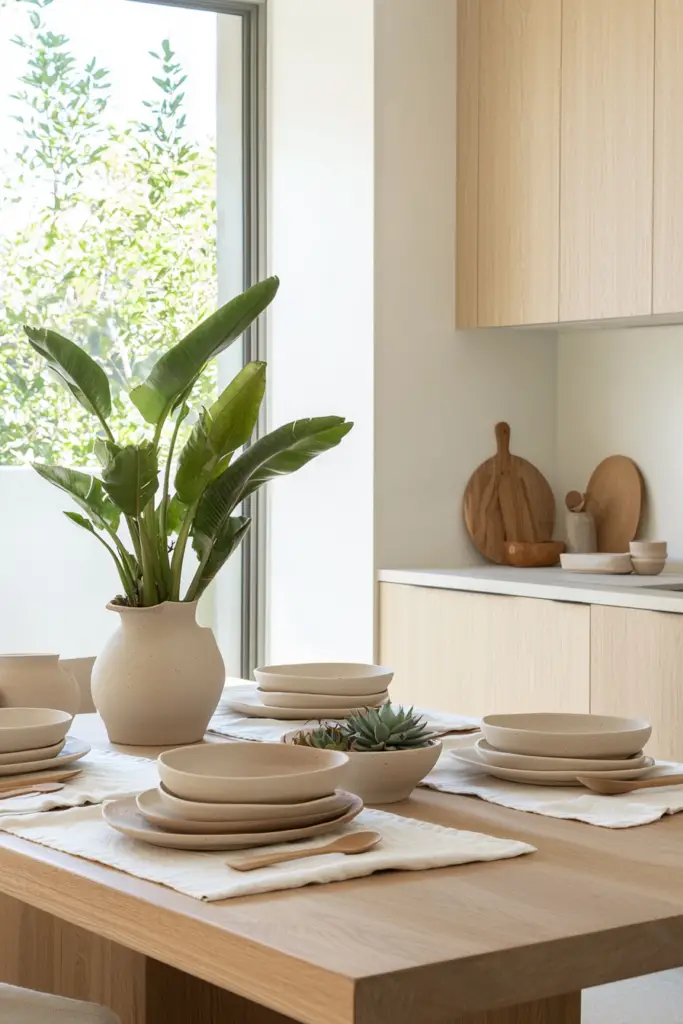
Tableware can greatly influence the overall vibe of your Japandi kitchen, so opting for simple designs is key. Choose plates and bowls with clean lines and neutral tones, allowing the beauty of your food to shine through. Consider handcrafted ceramics that showcase subtle textures, adding character without overwhelming your space. Pair these with minimalist utensils, like wooden or stainless-steel options, to maintain that elegant yet functional aesthetic. Don’t shy away from layering—stacking simple plates can create an inviting display while saving space. By selecting tableware that embodies simplicity, you’ll foster a serene atmosphere that aligns perfectly with Japandi principles. This thoughtful approach not only enhances your dining experience but also reflects a lifestyle rooted in balance and harmony.
19.Implement Soft Textures
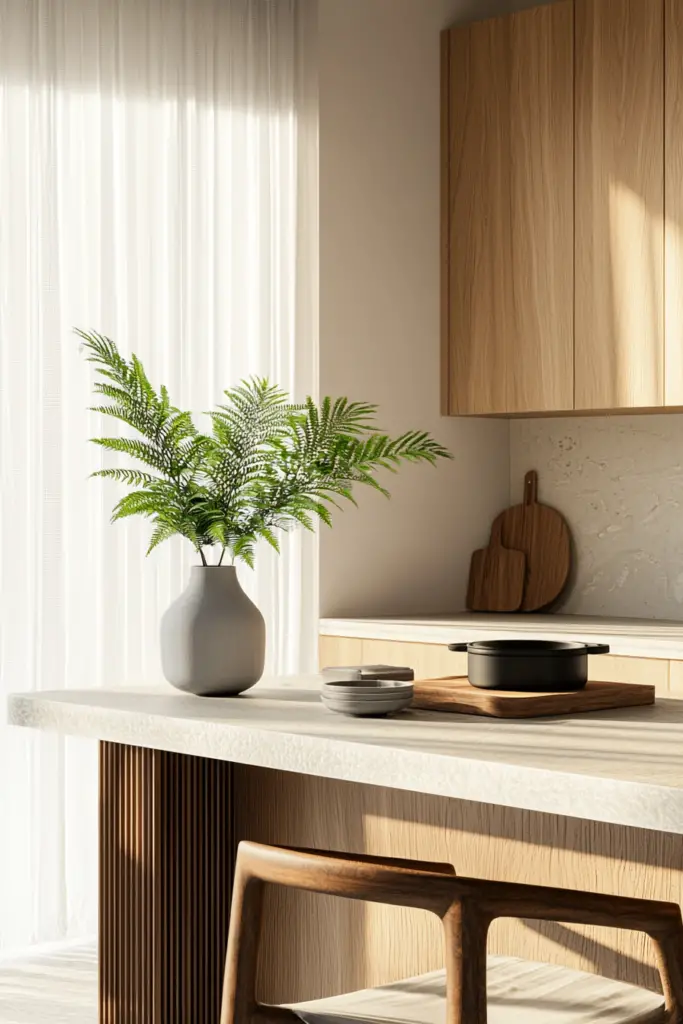
There’s something undeniably inviting about soft textures in a Japandi kitchen. Incorporating elements like linen dish towels, plush area rugs, and woven baskets instantly adds warmth and comfort to the space. You can opt for natural fabrics that harmonize with the minimalist aesthetic, enhancing the earthy feel. Think about layering textiles—perhaps a soft cotton table runner atop a simple wooden table. These layers not only elevate the visual appeal but also create a tactile experience. Incorporate cushions on seating areas with muted tones, allowing you to relax while enjoying your culinary endeavors. By blending these soft textures, you’re not just decorating; you’re crafting a serene environment that resonates with the Japandi philosophy of balance and simplicity.
20.Design a Cozy Breakfast Nook
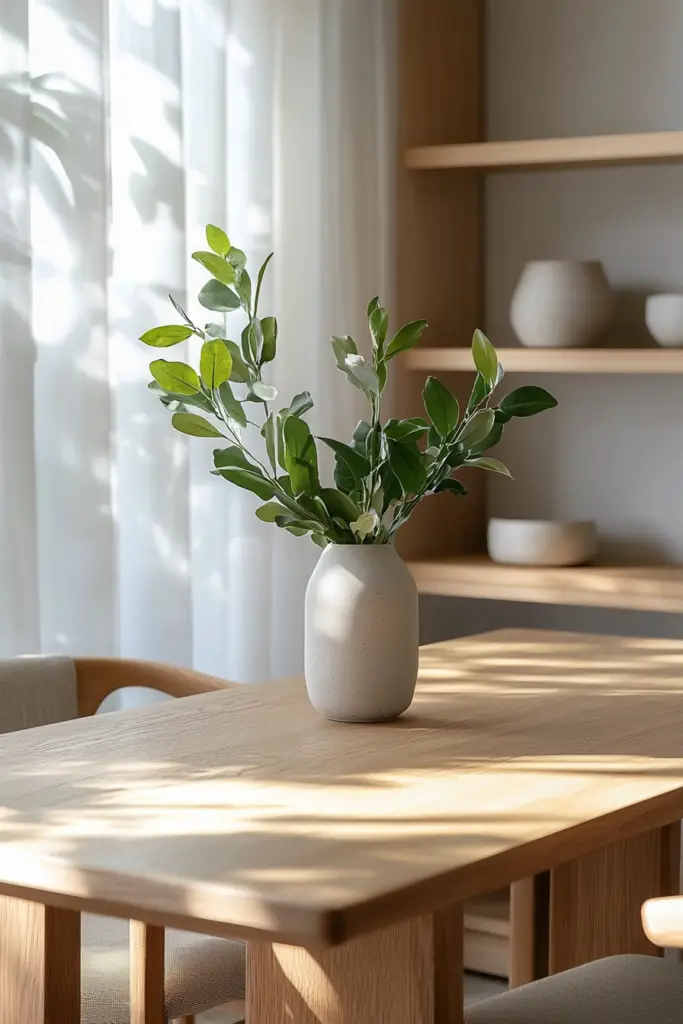
A cozy breakfast nook can transform your Japandi kitchen into a delightful retreat for morning meals. Picture a simple wooden table surrounded by plush, low-profile seating that invites you to linger. Soft, natural fabrics in muted tones can enhance comfort, while a few plants add a touch of nature, creating a serene atmosphere. Consider a built-in bench with storage underneath, merging functionality with elegance. A gentle, warm light fixture overhead can create an inviting glow, perfect for those early hours. You might also incorporate a small shelf for your favorite books or a curated selection of pottery, marrying beauty with practicality. This nook becomes not just a place to eat, but a cherished space for connection and inspiration.
21.Use Minimalist Decor
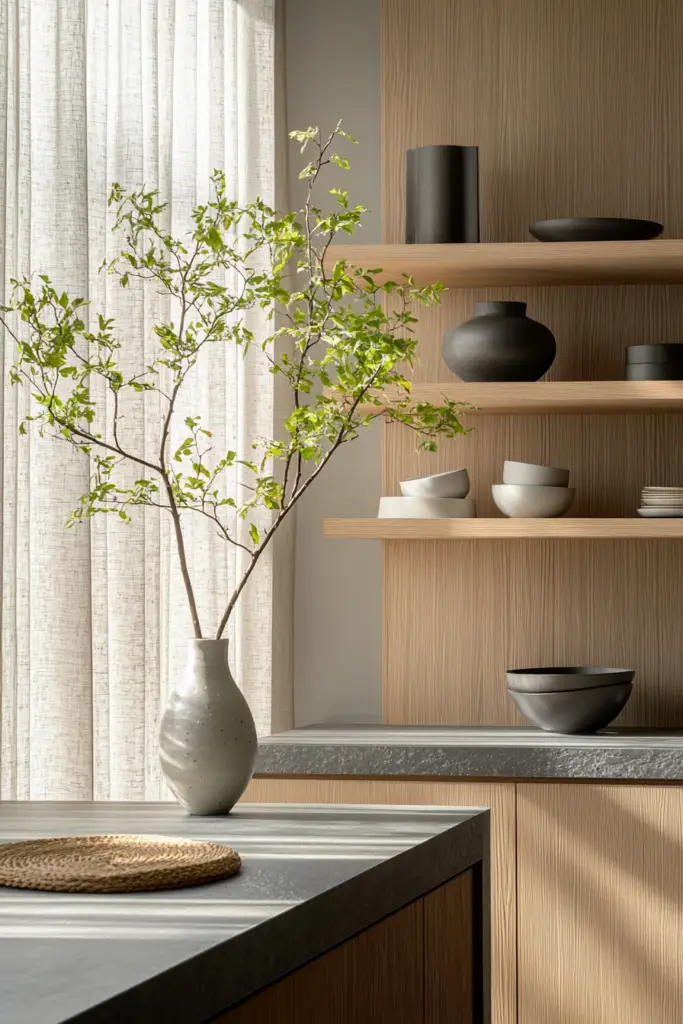
While embracing the essence of Japandi design, using minimalist decor can considerably enhance the tranquility of your kitchen. Start by decluttering surfaces; this creates an open, airy feel. Choose sleek, functional kitchen tools that blend beauty with practicality—think wooden spoons or ceramic containers. Consider a few thoughtfully placed pieces, like a simple vase or a unique bowl, to add a touch of personality without overwhelming the space. Keep cabinetry streamlined and unadorned, focusing on clean lines and natural finishes. Soft textiles, such as linen dish towels, can introduce a touch of warmth while maintaining a minimalist approach. By prioritizing simplicity and functionality, you’ll cultivate a serene atmosphere that perfectly embodies the Japandi philosophy.
22.Incorporate Earthy Color Tones
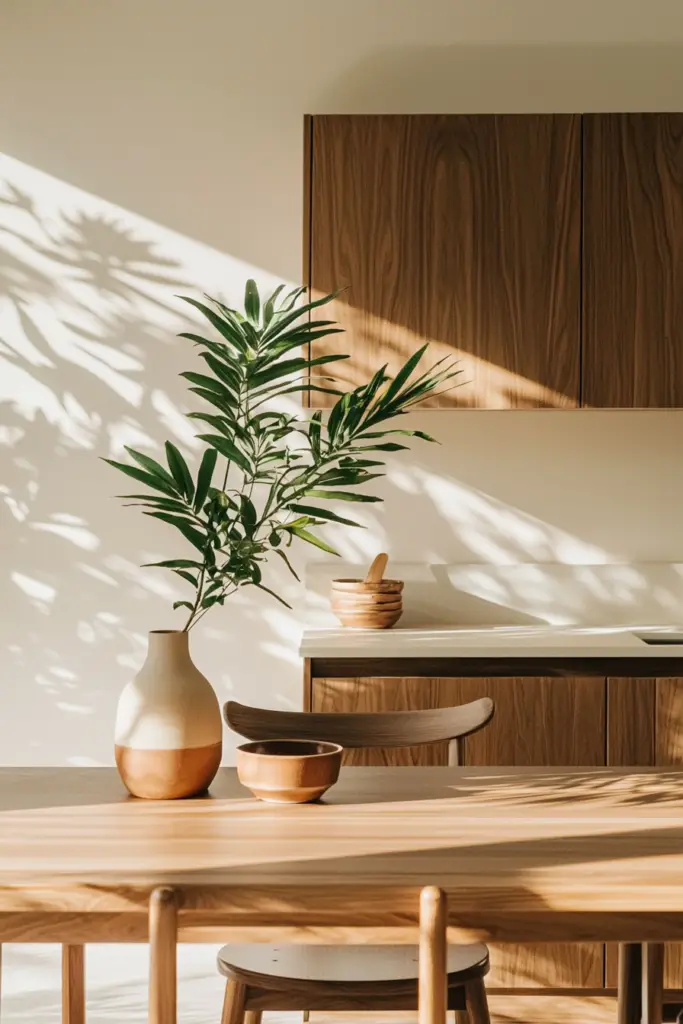
To truly embody the Japandi aesthetic, incorporating earthy color tones is a natural progression from the minimalist decor you’ve already embraced. Think soft browns, muted greens, and gentle terracotta that evoke a sense of calm and connection to nature. These colors can be applied through your cabinetry, wall paint, or decorative accents, creating a warm, inviting atmosphere. Consider using natural materials like wood and stone to enhance the earthy palette; they harmonize beautifully with these tones while adding texture. A simple, sage-green backsplash or warm beige countertops can serve as focal points, grounding the space. By weaving these earthy shades into your design, you’ll create a serene kitchen that feels both elegant and effortlessly functional.
23.Add a Touch of Craftsmanship
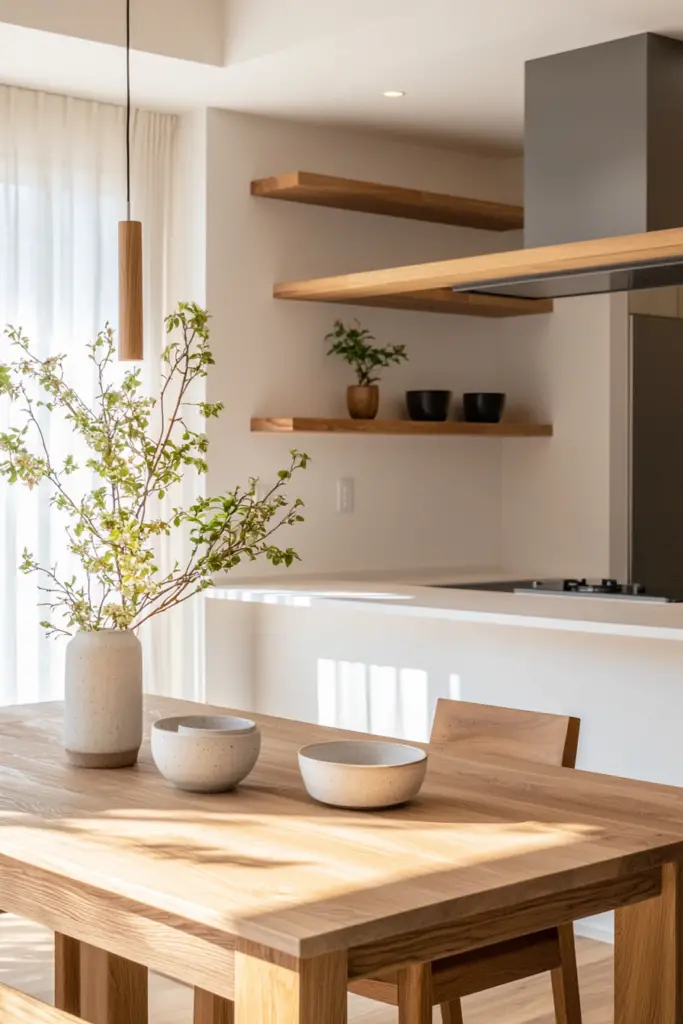
Incorporating handcrafted elements into your Japandi kitchen not only elevates its aesthetic but also adds a personal touch that reflects your unique style. Consider introducing artisanal ceramics, with their organic shapes and earthy glazes, which can serve as both functional dishware and decorative accents. A hand-carved wooden cutting board or serving platter can add warmth, while showcasing expert craftsmanship. You might also explore custom cabinetry, where the wood grain tells a story of its own, emphasizing simplicity and elegance. Even small details, like handwoven textiles or unique utensils, can enhance the overall design. By blending these handcrafted elements, you create a kitchen that feels inviting and thoughtfully curated, embodying the heart of Japandi design.
24.Focus on Sustainability
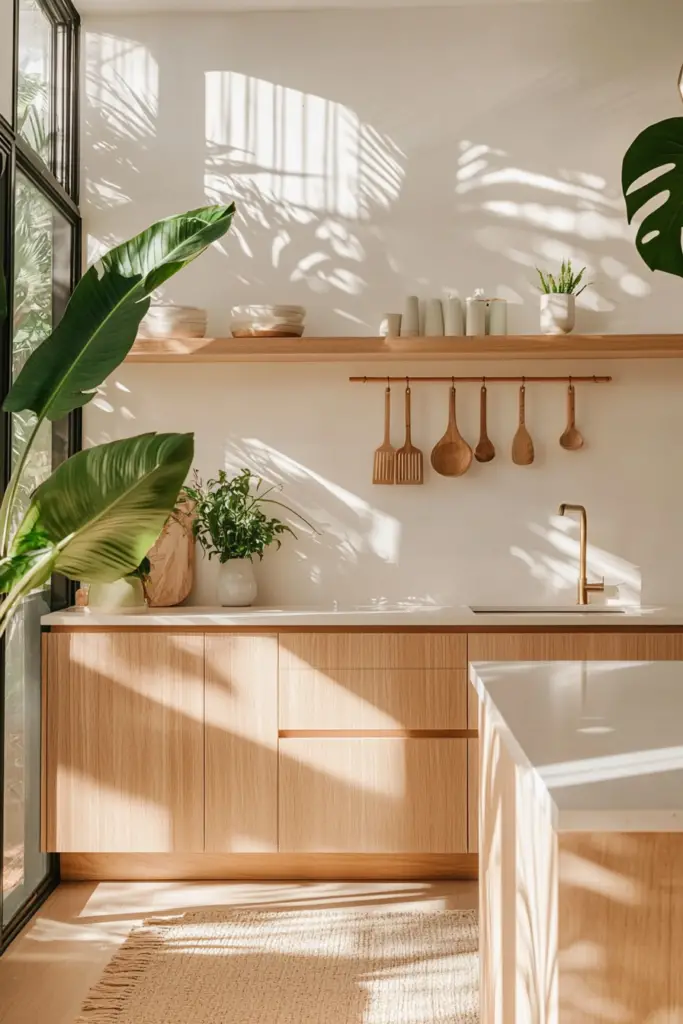
Handcrafted elements naturally lead to a broader commitment to sustainability in your Japandi kitchen. When you choose locally sourced wood for cabinetry or reclaimed materials for countertops, you’re not just enhancing the aesthetic; you’re making an eco-friendly choice. Opt for energy-efficient appliances that blend seamlessly into your design, keeping functionality at the forefront while reducing your carbon footprint. Incorporating plants, whether through herbs on the windowsill or a green wall, not only purifies the air but also connects you to nature. By selecting low-VOC paints and finishes, you guarantee a healthier environment for your family. Every decision you make in this space can reflect your values, creating a beautiful, sustainable kitchen that’s both elegant and mindful of the planet.
25.Create a Harmonious Flow
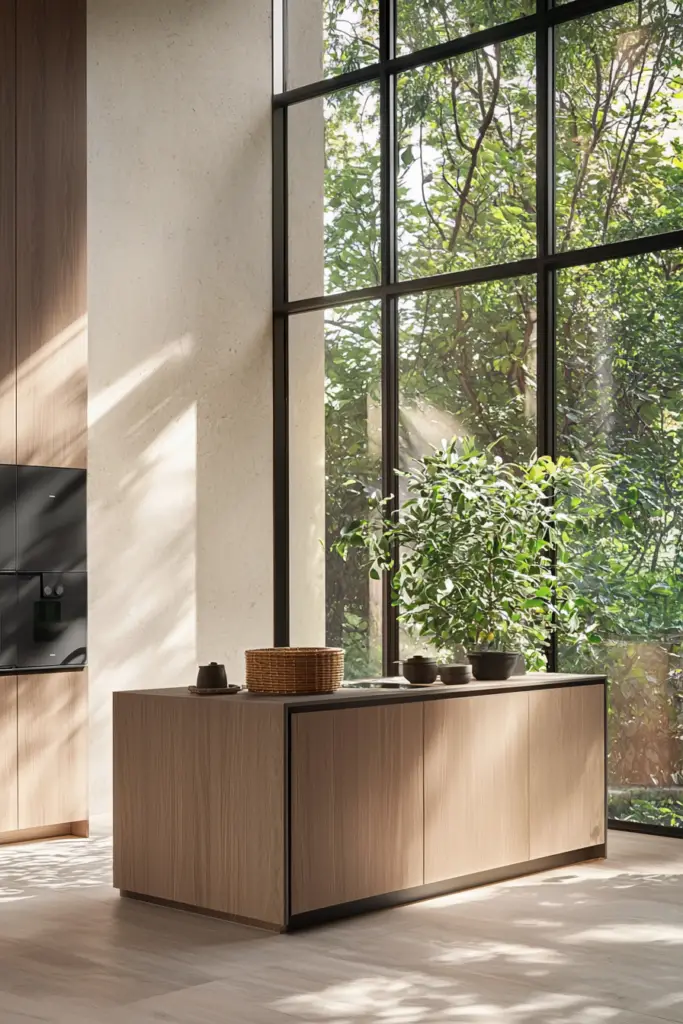
Creating a harmonious flow in your Japandi kitchen is essential for both aesthetics and functionality, guaranteeing that every element works together seamlessly. Start by choosing a neutral color palette, blending warm woods with soft whites or grays. This combination creates a calming backdrop that enhances natural light. Next, consider the layout; an open design fosters movement and connection between cooking and dining areas. Incorporate multifunctional furniture, like a wooden island that doubles as a prep space and a gathering spot. Add thoughtful decor, such as handcrafted ceramics or minimalistic plants, to bring warmth without overwhelming the space. Finally, guarantee that storage solutions are both stylish and practical, keeping surfaces clutter-free and maintaining that essential Japandi balance of elegance and simplicity.
Conclusion
By embracing the Japandi style, you can transform your kitchen into a serene sanctuary. Picture natural materials, neutral tones, and minimalistic cabinetry working in harmony to create an inviting space. Open shelving showcases your favorite items while textured fabrics add warmth. Earthy hues and thoughtful craftsmanship bring character, all while emphasizing sustainability. This elegant yet simple aesthetic not only elevates your cooking experience but also fosters a calming atmosphere where you can truly connect with your home.